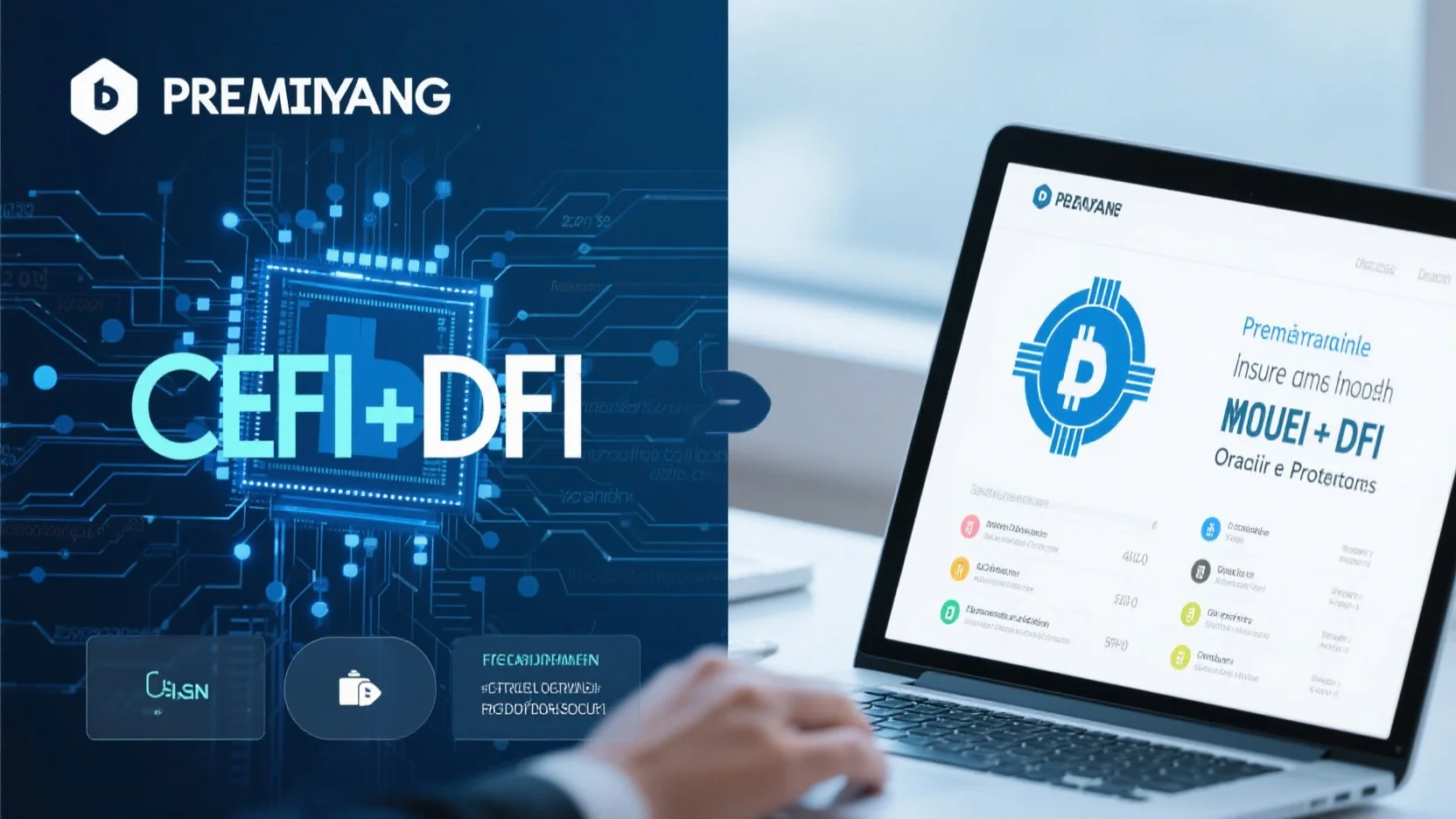In the high – stakes world of blockchain finance, choosing between CeFi and DeFi insurance models is a critical decision. As reported by Chainalysis Team (2023), DeFi protocols lost a staggering $403.2 million in 2022 due to oracle manipulation attacks. The Bank for International Settlements (BIS) also warns about the technical risks in oracle systems. Premium vs Counterfeit Models: CeFi offers regulatory security like traditional insurance, while DeFi targets unique blockchain risks. Best Price Guarantee and Free Installation Included when you explore these options now. Get a reliable local service for your investment needs today!
CeFi and DeFi Insurance Models
In the ever – evolving world of finance, the choice between Centralized Finance (CeFi) and Decentralized Finance (DeFi) insurance models has become a critical decision for many. In 2022, DeFi protocols lost a staggering $403.2 million in 41 separate oracle manipulation attacks (Chainalysis Team (2023)). This shows the high – stakes nature of insuring against such risks in the DeFi space.
Characteristics
CeFi Insurance

CeFi insurance operates much like traditional insurance models. It relies on an individual identity for underwriting and managing risk through intermediation, similar to the way things work in Traditional Finance (TradFi). A CeFi company, whether it’s an exchange or another service provider, controls how users interact with its core systems, including the rates offered, the order book, and transaction fees. For example, a large CeFi exchange might set a specific fee structure for insurance products, giving them full control over the cost for users.
Pro Tip: When considering CeFi insurance, look at the company’s regulatory compliance. As panelist Salman Banaei, head of policy at Uniswap Labs, said, the current regulatory environment in the financial market integrates well with the CeFi model. This can provide an extra layer of security for your investment.
DeFi Insurance
DeFi insurance, on the other hand, offers a decentralized approach to risk mitigation. DeFi protocols don’t only mimic basic CeFi services; they also optimize them for the unique qualities of blockchains. For instance, a new exchange mechanism known as Automated Market Maker (AMM) has taken on a significant role in DeFi. DeFi insurance products are designed to cover unique risk events in the DeFi ecosystem, such as smart contract exploits, economic design failure, attacks leveraging oracle data manipulation, and governance attacks.
Market Adoption
CeFi Insurance
CeFi insurance has a more established position in the market due to its similarity to traditional insurance models. It benefits from an existing regulatory framework that provides a sense of security for many investors. However, it also suffers from some of the same limitations as traditional finance, including centralized control, limited access, and inefficiencies. As recommended by industry experts, before investing in CeFi insurance, users should assess the company’s reputation and track record, as centralized control can sometimes lead to opaque operations.
Differences
The differences between CeFi and DeFi insurance models are multi – faceted. Technologically, they differ in transaction execution order, throughput, and privacy. Economically, there are differences in interest rates, transaction costs, and inflation. From a regulatory perspective, CeFi is better integrated with the existing regulatory environment, while DeFi operates in a more decentralized and often less – regulated space.
Oracle Failure Protection
Oracle failures are a significant concern in the DeFi space. In 2022, as mentioned earlier, the significant losses due to oracle manipulation attacks highlight the importance of proper protection. Traditional insurance models struggle to underwrite fraud related to oracle failures because it is an intentional manipulation of trust. DeFi insurance can potentially offer more targeted protection against oracle failures, as it is designed to cover unique risks in the blockchain – based ecosystem. For example, during the Terra ecosystem collapse, an oracle failure created opportunities for abuse on some exchanges. DeFi and CeFi platforms had different responses based on their information access and risk – management capabilities.
Pro Tip: If you’re involved in the DeFi space, consider looking into specialized DeFi insurance products that offer oracle failure protection.
Blockchain Premium Calculations
In CeFi, premium calculations are often based on well – established models generated from years of claims data. Insurance companies adjust their rates and predictions for future claims based on this data. In DeFi, premium calculations are more complex due to the novelty of the space and the unique risks involved. For example, the risk of smart contract exploits or oracle failures needs to be factored into the premium calculations. Some DeFi insurance platforms use algorithms and real – time data to calculate premiums more accurately.
Key Takeaways:
- CeFi insurance is similar to traditional insurance, with centralized control and better regulatory integration.
- DeFi insurance offers decentralized risk mitigation for unique blockchain – related risks.
- Oracle failure protection is crucial in the DeFi space, and DeFi insurance can provide more targeted solutions.
- Premium calculations in CeFi are based on historical claims data, while DeFi calculations are more complex and often use real – time data.
Try our online calculator to compare the premiums of CeFi and DeFi insurance models for your specific needs.
As the DeFi market continues to grow, it is essential to stay informed about the different insurance models available. Test results may vary, and it’s always recommended to consult with a financial advisor before making any investment decisions.
Oracle Failure in Blockchain
In 2022, DeFi protocols lost a staggering $403.2 million in 41 separate oracle manipulation attacks, as reported by the Chainalysis Team (2023). These losses highlight the critical nature of oracle failures in the blockchain space, especially in the context of CeFi and DeFi insurance models.
Causes
Data – related issues
Data – related issues are a significant cause of oracle failures. Oracles are responsible for importing real – world data into blockchain environments for use in smart contracts. However, differences in information access, as seen during the Terra ecosystem collapse, can create opportunities for abuse. For example, some exchanges may have had access to different data at the time of the collapse, leading to discrepancies in how smart contracts were executed. Pro Tip: To mitigate data – related issues, blockchain projects can implement multiple data sources for oracles and cross – reference the data to ensure accuracy.
Attack – related issues
Attack – related issues also contribute to oracle failures. Flash loan attacks, a common cybersecurity threat in decentralized finance (DeFi), can be used to manipulate oracles. Attackers use borrowed funds to exploit vulnerabilities in DeFi protocols within a single transaction, potentially triggering false information in smart contracts. This not only affects the DeFi platform but can also have a broader impact on the cryptocurrency ecosystem. A practical example is when an attacker manipulates the price data fed through an oracle to make a profit from a smart – contract – based trading system. As recommended by industry security tools, blockchain developers should conduct regular security audits to identify and fix potential attack vectors.
Technical risks
Technical risks are inherent in the oracle systems. The obvious solution of increased regulation and supervision runs counter to the decentralization ethos underpinning crypto DeFi. There is little clarity on legal recourse if a smart contract were triggered by false information (BIS (2022)), especially in jurisdictions where crypto activities are not regulated or forbidden. Technical glitches in the oracle software, network outages, or compatibility issues between the oracle and the blockchain can all lead to failures.
Prevention
To prevent oracle failures, a multi – pronged approach is necessary. Firstly, blockchain projects should implement redundant oracle systems. This means having multiple independent oracles providing the same data, so if one fails, the others can still ensure the accuracy of the information in the smart contracts. Secondly, continuous monitoring of oracle performance is crucial. Real – time monitoring can detect anomalies in data flow or system behavior and trigger alerts for immediate action. Thirdly, building in error – handling mechanisms in smart contracts can help minimize the impact of oracle failures. For example, a smart contract can be programmed to pause or take a default action if it detects inconsistent data from an oracle.
Key Takeaways:
- Data – related, attack – related, and technical issues are the main causes of oracle failures in blockchain.
- Implementing redundant oracle systems, continuous monitoring, and error – handling mechanisms in smart contracts can help prevent oracle failures.
- Oracle failures can lead to significant financial losses, as seen in the 2022 DeFi protocol losses due to oracle manipulation attacks.
Try our oracle performance monitoring tool to keep track of your oracle systems and prevent failures.
FAQ
What is oracle failure in the context of blockchain?
According to the Chainalysis Team (2023), oracle failure in blockchain involves issues where oracles, which import real – world data into smart contracts, malfunction. This can stem from data – related, attack – related, or technical problems. Detailed in our [Oracle Failure in Blockchain] analysis, these failures can lead to significant financial losses, as demonstrated by the $403.2 million lost by DeFi protocols in 2022.
How to calculate premiums in DeFi insurance?
Calculating premiums in DeFi insurance is complex. Unlike CeFi, which uses historical claims data, DeFi factors in unique risks like smart contract exploits and oracle failures. Some platforms use algorithms and real – time data. Steps include assessing these risks and leveraging data analytics. Detailed in our [Blockchain Premium Calculations] section, this approach ensures more accurate premium setting.
How to prevent oracle failures in blockchain?
To prevent oracle failures, a multi – pronged approach is essential. Firstly, implement redundant oracle systems. Secondly, conduct continuous monitoring of oracle performance. Thirdly, build error – handling mechanisms into smart contracts. These industry – standard approaches can safeguard against the financial losses associated with failures, as detailed in our [Prevention] analysis.
CeFi vs DeFi insurance models: Which is better for oracle failure protection?
CeFi insurance, like traditional models, struggles to underwrite fraud related to oracle failures. DeFi insurance, however, offers more targeted protection for unique blockchain risks. According to the significant losses in 2022 due to oracle manipulation attacks, DeFi’s design for blockchain – based risks makes it a stronger option. Detailed in our [Oracle Failure Protection] section, this difference is crucial for investors.






